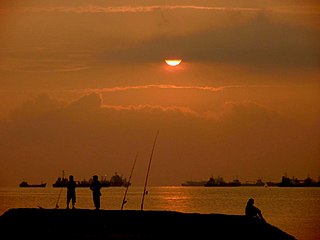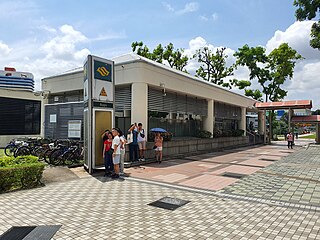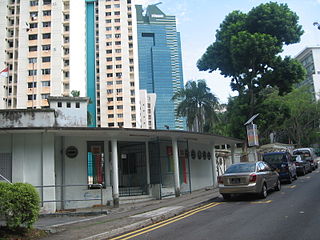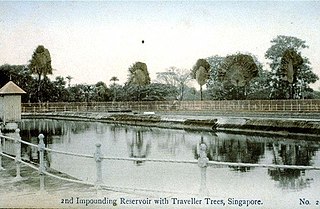
The Pan Island Expressway is the oldest and longest expressway in Singapore. It is also Singapore's longest road. The expressway runs from the East Coast Parkway near Changi Airport in the east to Tuas in the west and has a total length of 42.8 kilometres.

Bedok Reservoir is a reservoir in the eastern part of Singapore, to the north of Bedok. The reservoir has a surface area of 880,000 m2, and a capacity of 12.8 million m3. The mean depth of the reservoir is 9 m, with a maximum depth of 18.2 m. The shoreline length is 4.3 km.

East Coast Park is a beach and a park on the southeastern coast of Singapore. It stretches along the south of Marine Parade, Bedok, and Tampines. It was opened in the 1970s, after the Singapore government had completed reclaiming land off the coast at Katong, from Kallang to Changi. Themed "Recreation for All", it not only serves the needs of communities in the east, other Singapore residents do also visit the park for sports, recreation, and food.

Bugis MRT station is an underground Mass Rapid Transit (MRT) interchange station on the East–West (EWL) and Downtown (DTL) lines, in Bugis, Singapore. The station is located underneath the junction of Rochor Road and Victoria Street. Various developments surrounding the station include Bugis Junction, Raffles Hospital and the National Library. The station is also close to Kampung Glam.

Lavender MRT station is an underground Mass Rapid Transit (MRT) station on the East West line in Kallang, Singapore. Located under Kallang Road, the station is close to the Immigration and Checkpoints Authority (ICA) Building and Jalan Besar Stadium. Planned and built as part of Phase Two of the initial system. The contract for the station's construction was awarded in October 1985, and it was opened in November 1989.

The Singapore Improvement Trust (SIT) is a former government organisation that was responsible for urban planning and urban renewal in Singapore. Formally established in 1927 under the Singapore Improvement Ordinance, it was modelled after similar organisations in India. The SIT initially carried out back lane improvement schemes and marking out unsanitary buildings for demolition, but began constructing public housing from 1935. After 1945, the SIT initially focused its efforts on the repair of its residential developments. It resumed constructing public housing in 1947 but was unable to keep up with demand. The SIT was also involved in the development of a "Master Plan", which set out Singapore's developmental direction, from 1952 to 1958. In the late 1950s, plans were set out to replace the SIT with two departments—housing and planning—culminating in two bills that were passed in 1959. With the establishment of the successor organisations by the government of Singapore, the Housing and Development Authority and the Planning Authority, in 1960, the SIT was dissolved.

Mount Faber, formerly Telok Blangah Hill, is a hill about 94 metres (308 ft) in height, located in the town of Bukit Merah in the Central Region of Singapore. It overlooks the Telok Blangah area and the western parts of the Central Area. The summit is accessible by Mount Faber Road or Mount Faber Loop via Morse Road, but there are many footpaths or trails leading up the hill. The main paths are: Marang Trail, which leads from Marang Road at the Harbourfront MRT station, and the Southern Ridges Park Connector which connects from Telok Blangah Hill Park, Kent Ridge Park, and Henderson Waves.

Maris Stella High School (MSHS) (Chinese: 海星中学; pinyin: Hǎixīng Zhōngxué) is a government-aided, all-boys Catholic secondary school with autonomous status. As a full school, it comprises a primary section offering a six-year programme leading up to the Primary School Leaving Examination, as well as a secondary section offering a four-year programme leading up to the Singapore-Cambridge GCE Ordinary Level examinations. Run by the international Marist Brothers at Mount Vernon Road, Singapore near Bartley MRT station, Maris Stella High School is one of the eleven Special Assistance Plan(SAP) high schools in Singapore.
Mark Chay Jung Jun is a Singaporean Nominated Member of Parliament and freestyle swimmer who has represented the country at the Summer Olympics

Chinese Garden is a park in Jurong East, Singapore. Built in 1975 by the JTC Corporation, the Chinese Garden's concept is based on Chinese gardening art. The main characteristic is the integration of architectural features with the natural environment. The Chinese Garden is modeled along the northern Chinese imperial style of architecture and landscaping. It is located next to Chinese Garden MRT station and connected to the adjacent Japanese Garden by a bridge. Along with Japanese Garden and Lakeside Garden, that was opened in 2019, the three gardens are collectively known as the Jurong Gardens.

The Bank of China Building is a development consisting of two skyscrapers located in the central business district of Singapore. It is located on 4 Battery Road, adjacent to 6 Battery Road, Maybank Tower, and roughly 100 metres from the Fullerton Hotel. The Tower serves as the headquarters for the Bank of China.
Van Kleef Aquarium was an oceanarium located along River Valley Road, at the foot of Fort Canning Hill, in Singapore. Fully air-conditioned, the aquarium had 6,500 animals at the time of opening, which were housed in freshwater, seawater, and swamp tanks respectively.

Yan Kit Swimming Complex, located along Yan Kit Road, was the second public swimming pool in Singapore, opening in 1952 and closing in April 2001. The complex cost a total of $513,000 and pool users had to pay fifteen cents per entry. The complex closed due to a daily attendance of only 120 users by 2001.
David Joseph Murnane (1892–1953) was Singapore's longest serving municipal water engineer, serving from 1925 to 1947.
Robert Peirce was a British-born civil engineer who served as Municipal Engineer in Penang, Malaysia and Singapore.
The Keppel Hill Reservoir is an abandoned reservoir near Mount Faber in the southern part of Singapore. It was built during the colonial period of Singapore. It fell into disuse due to its small capacity and was eventually forgotten.

Mount Emily Reservoir was a reservoir originally designed to bring water supply to the town of Singapore. It was in operation from 1878 until it was not required with the completion of Fort Canning Reservoir in 1929. It was converted into a swimming pool and was reopened in 1931.

Bukit Brown Cemetery, also known as the Bukit Brown Municipal Cemetery or the Bukit Brown Chinese Cemetery, is a cemetery located in Novena, in the Central Region of Singapore. The site of the cemetery was originally owned by George Henry Brown, a British merchant. Due to its hilly terrain, the site became known as Brown's Hill, which was translated into Malay as Bukit Brown.

Outram Prison, also known as Pearl's Hill Prison or Civil Jail, was a prison at Pearl's Hill, Outram, Singapore. Originally occupied and known as the Civil Jail, Outram Prison was opened in 1882 and served as the main prison complex before the construction of Changi Prison in 1936.

















